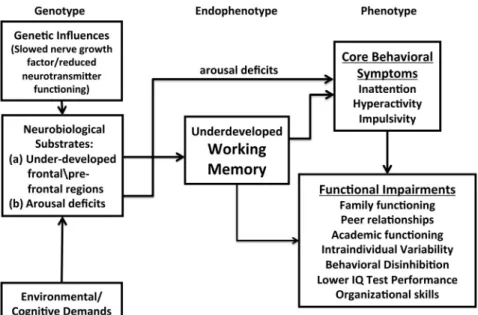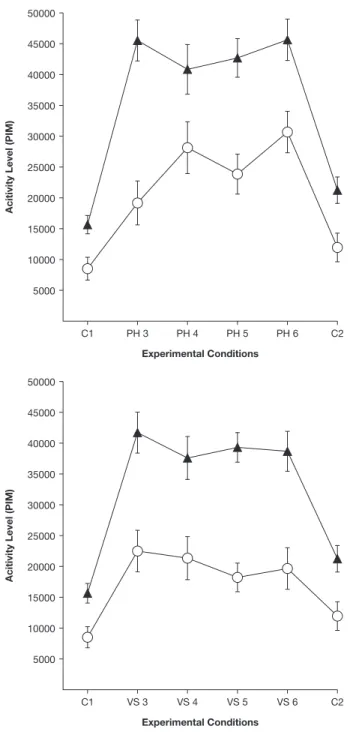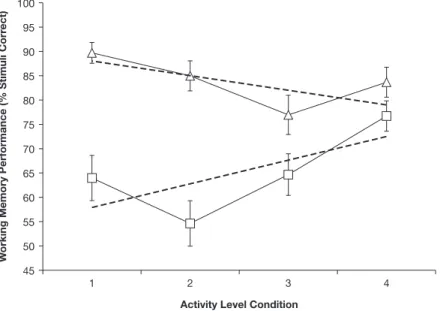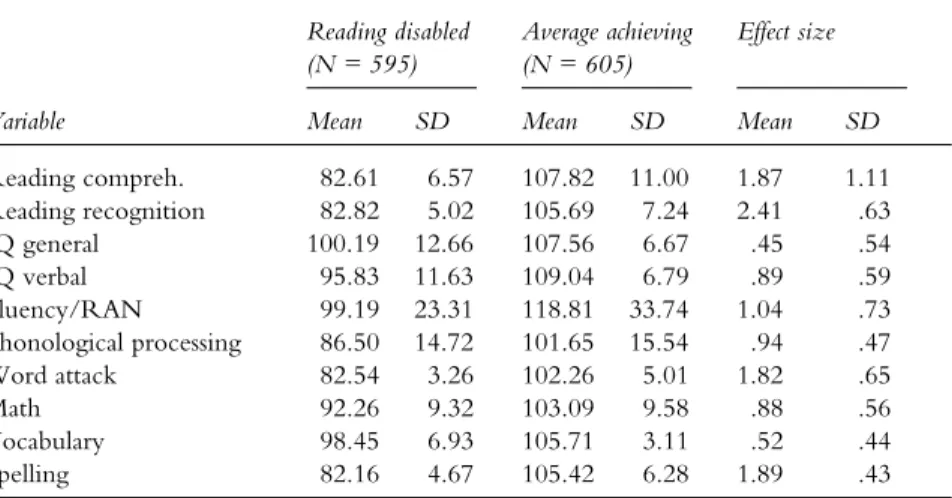Each chapter describes the disorder and examines working memory and associated executive function deficits. The main characteristic of working memory is the ability to store and manipulate information.
Neurodevelopmental disorders
The authors also discuss the role of working memory in developmental mathematical thinking, as well as in SLD math. The authors also look at the effectiveness of using adaptive computer-aided visual-spatial working memory training delivered in the school context to children with Down syndrome.
Neurocognitive disorders
For example, verbal working memory tasks such as recalling digits can produce floor effects, even in adults.
Depressive disorders
Verbal and non-verbal working memory and performance on National Curriculum tests at 11 and 14 years of age. -term memory and working memory - Both contribute to our understanding of academic performance in children and adults with learning disabilities.
WORKING MEMORY AND INTELLECTUAL DISABILITIES
It can be assumed that about 85% of people with intellectual disabilities have mild problems (they are slower in all areas of conceptual development and social/daily life skills, but can live independently with minimal support); One hypothesis is that verbal rehearsal, and thus the maintenance mechanism of the phonological loop, is impaired in individuals with intellectual disability.
MEMORY AND LANGUAGE IN CHILDREN WITH SLI
Archibald and Gathercole (2007) examined the influence of verbal and nonverbal short-term memory storage and processing abilities on complex storage (remembering in complex WM tasks) of children with SLI. Interestingly, the attentional processing of children with SLI (indexed by ERP) becomes more like TD children after receiving narrative language intervention (Popescu, Fey, Lewine, Finestack, & Popescu, 2009).
WORKING MEMORY AND AUTISM
Individuals with ASD are also challenged in working memory tasks as the memory load increases. Further analysis of the effects of positive reinforcement on working memory in children with autism.
WORKING MEMORY
AND ATTENTION-DEFICIT/
HYPERACTIVITY DISORDER
Existing evidence suggests that children with ADHD show large deficits in the CE components of WM (Rapport, Alderson, Kofler, Sarver, Bolden, & Sims, 2008), which are functionally related to inattention (Kofler, Rapport, Bolden, Sarver, & Raiker, 2010; Orban, Rapport, Friedman, Eckrich, & Kofler, 2017), hyperactivity (Rapport, Bolden, Kofler, Sarver, Raiker, & Alderson, 2009) and impulsivity (Raiker, Rapport, Kofler, & Sarver, 2012) . In general, task-based fMRI studies reveal hypoactivation of the frontostriatal, frontoparietal, and mesocorticolimbic circuits in children with ADHD relative to TD children. A popular theory related to altered neuronal connectivity in children with ADHD involves the default mode network (DMN).
The most debated controversy in this field currently is whether the well-documented excessive motor activity observed in children with ADHD-. Concomitant hypoactivation of frontostriatal, frontoparietal, and mesocorticolimbic circuits in children with ADHD are also well documented. Applied problem solving in children with ADHD: The mediating roles of working memory and mathematical computation.
Moderators of working memory deficits in children with attention-deficit/hyperactivity disorder (ADHD): A meta-analytic review.
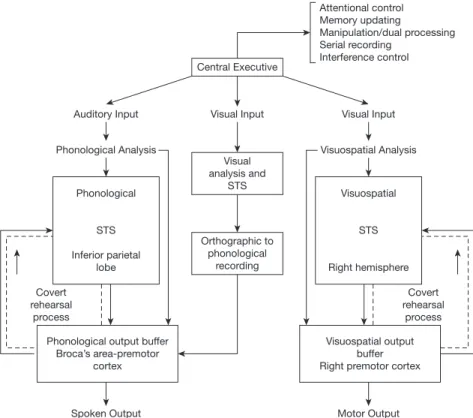
WORKING MEMORY AND SPECIFIC LEARNING
DISORDERS
Regarding the first question (the relationship between cognitive characteristics of rare disease and treatment outcomes), rare disease research reflects a dichotomy between those who study rare disease from a cognitive neuroscience perspective and those who focus primarily on intervention (referred to as Response to Intervention, RtI). In summary, a quantitative analysis of the literature clearly demonstrated that children with rare diseases perform worse than their peers on measures of STM for verbal information. Short-term memory and WM deficits are fundamental problems in children and adults with a rare disease.
A synthesis of the literature suggests that students with RD suffer deficits related to the phonological loop, a component of WM that specializes in retaining speech-based information. Working memory in children with reading disabilities and/or mathematical disabilities.Journal for Learning Disabilities. Cognitive processing deficits and students with specific learning disabilities: A selective meta-analysis of the literature. Learning Disability Quarterly.
Working memory, short-term memory, and reading disabilities: A selective meta-analysis of the literature. Journal of Learning Disabilities.
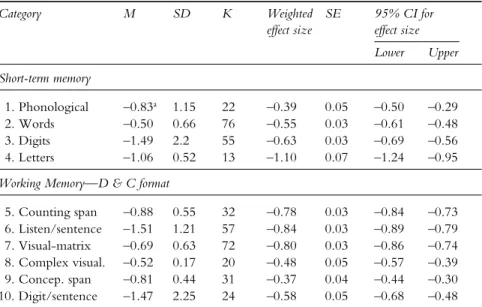
ROLE OF WORKING MEMORY IN THE LANGUAGE LEARNING
INDIVIDUALS WITH AND
WITHOUT SPECIFIC LEARNING DISABILITIES IN WRITTEN
LANGUAGE
For other evidence-based writing instruction grounded in a Working Memory conceptual framework, see Berninger, Rutberg, Abbott, et al. The relationship between working memory at the word and sentence level and reading and writing in second, fourth, and sixth grades. Modeling developmental core phonological deficits within a working memory architecture in children and adults with developmental dyslexia.
Generality and variability of working memory between skilled and less skilled readers. Journal of Educational Psychology. The role of working memory and dynamic assessment in classifying children with learning disabilities. The effect of working memory growth on reading and math performance in children with math and/or reading disabilities.
Mathematical problem solving and working memory in children with learning disabilities: Both executive and phonological processes are important.
DISABILITY
That is, some children with SLD math (and superior verbal memory) may over-learn number combinations when repetitive practice is an introductory instructional focus, but these overlearned facts may disappear once repetitive focus is no longer instructionally supported (Murphy & Mazzocco, 2008 ). It is therefore not surprising that poor working memory is a primary cognitive signature of SLD math (eg, Bull, Johnston, & Roy, 1999). However, a diagnosis of SLD math is not definitive proof of an individual's working memory function or capacity.
Here we briefly discuss the role of working memory in the development of mathematical thinking and then in SLD-mathematics. Individuals with mathematics SLD collectively show deficits in all three components of working memory (e.g., Geary et al., 2007), in early and later grades. Using the Working Memory Test Battery for Children (WMTB-C; Pickering & Gathercole, 2001), Geary, Hoard, Nugent, and Bailey (2012) showed that the working memory span of all children in their study increased from Level 1 to Level 5 .remained significantly lower in SLD-math children (relative to typically achieving or even low achieving students) at both grade levels and for all three components of working memory (except for a non-significant difference in visual-spatial sketchbook in 5th grade).
As mentioned above, other factors may explain some of the differences in the working memory and math SLD findings.
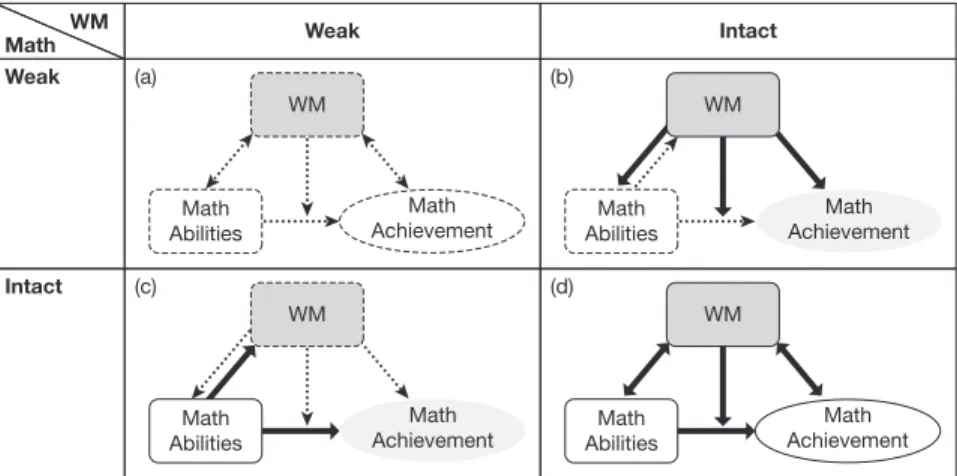
WORKING MEMORY AND LOW BIRTH WEIGHT
In summary, deficits in working memory and other related aspects of executive function are routinely implicated in children born with low birth weight. Furthermore, when orbital frontal volume decreased, early working memory scores (measured with the A-not-B task) of very low birth weight children increased. For example, studies have shown that low working memory capacity is associated with peer rejection.
Similarly, McQuade and colleagues (2013) found that verbal working memory was also related to social relationships. However, research on the functional impact of working memory deficits in preterm infants is more limited. Recent studies have investigated the impact of a computerized working memory training program (Cogmed JM program) in children born with very low birth weight, with promising early results.
Spatial working memory deficits in 3-4 year old low birth weight, preterm infants.
DEVELOPMENTAL
COORDINATION DISORDER AND WORKING MEMORY
Common visual deficits in children with DCD include poor tracking skills and three-dimensional vision (Macintyre, 2001). A comparison of working memory and learning abilities in children with developmental coordination disorder and moderate learning difficulties. Brief report: Response inhibition and processing speed in children with motor difficulties and developmental coordination disorder.
On the ability of children with developmental coordination disorder (DCD) to inhibit response initiation: the Simon effect. Parametric control of fingertip forces during precision grip lifts in children with DCD (developmental coordination disorder) and DAMP (deficits in attentional and perceptual motor control). Sensorimotor deficits in children with developmental coordination disorder, attention deficit hyperactivity disorder and autistic disorders.
Deficits in endogenous control of covert visuospatial attention in children with developmental coordination disorder.
WORKING MEMORY IN DOWN SYNDROME
Orsini et al., 1987) have been used as visuospatial measures of working memory for individuals with Down syndrome (Costanzo et al., 2013). The use of atypically developing comparison groups has enabled better defined profiles of working memory ability in Down syndrome. in the domain of working memory in Down syndrome, there is no consistency between appropriate measures and procedures (see Yang et al., 2014).
Instead of using a generic commercially available training program, Pulina and colleagues (2015) modified a computer-based working memory training program (Mammarella, Lucangeli, & Cornoldi, 2010) to target spatial-simultaneous working memory in individuals with Down syndrome. First, they demonstrate that children and adolescents with Down syndrome can be included in a computer-based working memory training program. The evidence for working memory training in Down syndrome is in its infancy and faces a number of challenges.
Examining working memory training effects for school-aged children (n = 41) with intellectual disabilities, researchers found that participants who were female without comorbid conditions and with higher baseline verbal working memory benefited most from working memory training (Söderqvist , Nutley, Ottersen). , Grill, & Klingberg, 2012).
WORKING MEMORY AND TBI
Although there is also evidence of WM deficits in patients with mild traumatic brain injury, these are found less consistently and tend to be less severe than in patients with moderate-severe traumatic brain injury. Neuroimaging studies have provided insight into the neural mechanisms underlying WM deficits in TBI patients. Thus, less is known about the extent to which complications related to the brain injury itself or to other disorders may exacerbate WM deficits in TBI patients.
Medications used to treat cognitive symptoms in TBI patients include those that modulate dopamine, norepinephrine, or acetylcholine neurotransmission. However, a double-blind, placebo-controlled crossover trial found no significant improvement in attention, memory, or WM in moderate-severe TBI patients (Ripley et al., 2014). Medications to treat insomnia in TBI patients include melatonin, trazodone, prazosin, and (with caution) benzodiazepines and sedative hypnotics.
Benzodiazepines may also be useful for short periods in the acute treatment of anxiety in TBI patients with PTSD, albeit with the significant caveats mentioned earlier.
